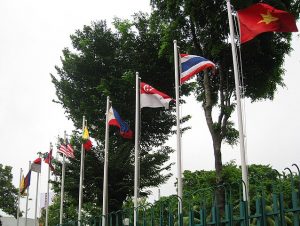China is stepping up its efforts to achieve the effective control and militarization of the South China Sea. In mid-May, the People’s Liberation Army announced that it had landed bombers, including an H-6K, on Woody Island, part of the Paracel Islands, over which China has taken effective control. According to the Asia Maritime Transparency Initiative (AMTI), it appears that China has established new military platforms, such as HQ-9 ground-to-air missiles, on Woody Island.
These actions pose a threat to ASEAN countries. However, China is becoming more active in providing these same countries with economic support and investment under its Belt and Road Initiative (BRI). Although ASEAN countries are vigilant about excessive economic dependence on China from a strategic perspective, they do look to Chinese money to accelerate their economic development and bolster ASEAN connectivity.
At the ASEAN Summit held at the end of April, the paragraph in the chairman’s statement mentioning the South China Sea issue reflected the ambivalent relationship between China and ASEAN countries in terms of the recognition of these threats and expectations. The statement expressed concerns about the situation in the South China Sea. ASEAN-related conferences held last year, when the Philippines had the chair, downplayed mention of the South China Sea issue, and the chairman’s statement at the summit held in November expressed no such concerns. Clearly, ASEAN’s position on the issue has changed, to one that is willing to express recognition of the threat. Singapore, the current ASEAN chair, emphasizes the stability of the regional maritime order and the rule of law, although it is not a litigant in the South China Sea sovereignty disputes. Instead, Singapore approached the situation with a sense of crisis about the possibility of China and other litigants forcibly changing the status quo.
In the chairman’s statement, the sentence noting the concern was inserted inconspicuously into a paragraph about the South China Sea issue that describes the favorable development of ASEAN’s relationship with China, including the development of a code of conduct. This underscores the reality that ASEAN countries have few options, because they must maintain good ties and deepen cooperation with China, even if the latter continues to assert its hegemony over the South China Sea. On the other hand, the paragraph can also be interpreted as an expression of the political will of ASEAN countries to highlight their interests and benefits as much as possible, avoiding direct confrontations with China and trying to maintain as much independence as possible in the current context.
ASEAN countries’ policy of maintaining good political ties with China despite the political tensions over the South China Sea issue can be seen in Chinese Premier Li Keqiang’s visit to Jakarta in early May, in the immediate wake of the ASEAN Summit. Meanwhile, ASEAN countries have reconfirmed their strategic partnerships with China. Yet the Philippines, which has been particularly cooperative with China, has reportedly begun to repair runways on Thitu Island, which it effectively controls. Their policy of cooperation with China notwithstanding, ASEAN member states clearly remain vigilant against Beijing’s actions, and are determined to protect their own interests, security and independence.
For ASEAN, a U.S. commitment is essential to exerting pressure on the growing Chinese presence and deterring Beijing from sweeping across the region. In response to Beijing’s activities in the South China Sea, the U.S. uninvited China from the 2018 Rim of the Pacific (RIMPAC) exercises, which will be held from the end of June to early August. China reacted angrily. The logic for small countries says that a retrained confrontation between the great powers surrounding them is not necessarily a net negative in terms of given them scope for independent action.
Exactly what the Trump administration will do is impossible to predict. President Donald Trump’s America First trade policy has directed criticism and sanctions at China. Like China, some ASEAN countries have large trade surpluses with the United States, so they could be targets of U.S. protectionist measures like economic sanctions.
Amid the regional uncertainty created by the great powers, ASEAN is being underutilized. In risk hedging terms, that is a serious policy failure.
Mie Oba is a professor at the Tokyo University of Science.

































